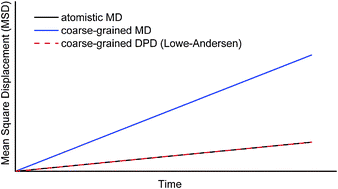Effective control of the transport coefficients of a coarse-grained liquid and polymer models using the dissipative particle dynamics and Lowe–Andersen equations of motion
Abstract
The dynamics of coarse-grained models obtained through iterative Boltzmann inversion [J. Comput. Chem., 2003, 24, 1624] is always faster than that of the parent atomistic models. In this work, the dissipative particle dynamics (DPD) and Lowe–Andersen (LA) equations of motion are applied in coarse-grained simulations to slow down the coarse-grained dynamics. Both methods provide effective friction and both conserve the linear momentum locally, so that they can be used for the calculation of viscosities. Coarse-grained models of liquid

- This article is part of the themed collection: Coarse-grained modeling of soft condensed matter

 Please wait while we load your content...
Please wait while we load your content...